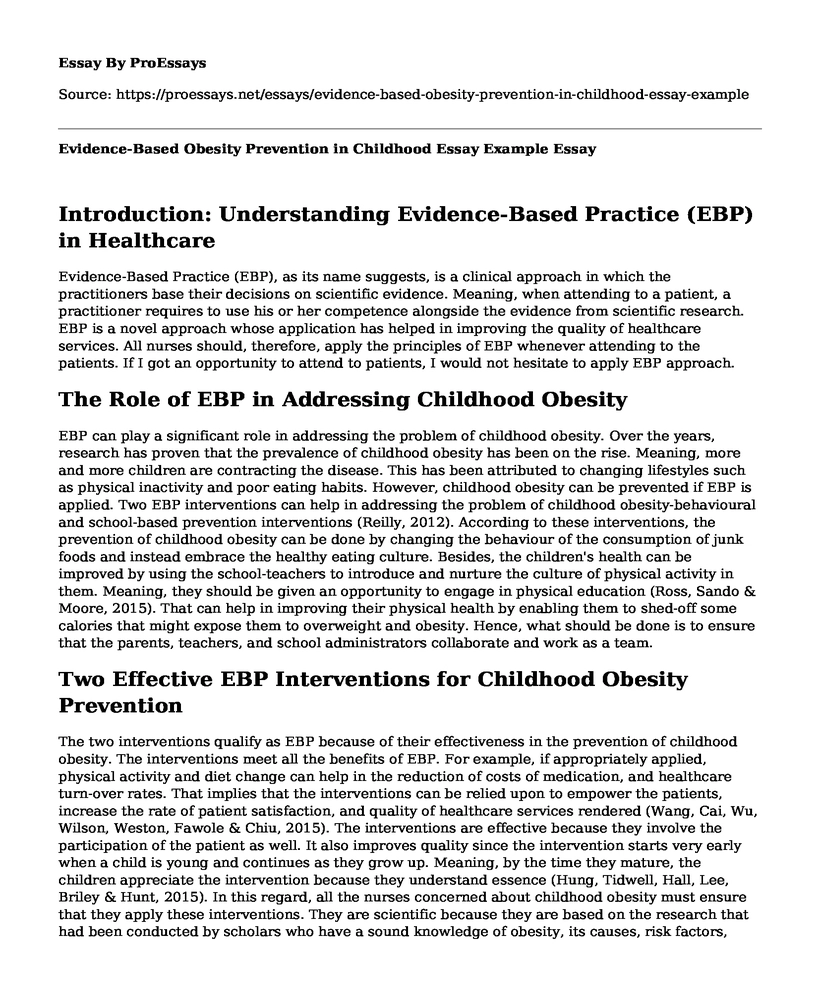Introduction: Understanding Evidence-Based Practice (EBP) in Healthcare
Evidence-Based Practice (EBP), as its name suggests, is a clinical approach in which the practitioners base their decisions on scientific evidence. Meaning, when attending to a patient, a practitioner requires to use his or her competence alongside the evidence from scientific research. EBP is a novel approach whose application has helped in improving the quality of healthcare services. All nurses should, therefore, apply the principles of EBP whenever attending to the patients. If I got an opportunity to attend to patients, I would not hesitate to apply EBP approach.
The Role of EBP in Addressing Childhood Obesity
EBP can play a significant role in addressing the problem of childhood obesity. Over the years, research has proven that the prevalence of childhood obesity has been on the rise. Meaning, more and more children are contracting the disease. This has been attributed to changing lifestyles such as physical inactivity and poor eating habits. However, childhood obesity can be prevented if EBP is applied. Two EBP interventions can help in addressing the problem of childhood obesity-behavioural and school-based prevention interventions (Reilly, 2012). According to these interventions, the prevention of childhood obesity can be done by changing the behaviour of the consumption of junk foods and instead embrace the healthy eating culture. Besides, the children's health can be improved by using the school-teachers to introduce and nurture the culture of physical activity in them. Meaning, they should be given an opportunity to engage in physical education (Ross, Sando & Moore, 2015). That can help in improving their physical health by enabling them to shed-off some calories that might expose them to overweight and obesity. Hence, what should be done is to ensure that the parents, teachers, and school administrators collaborate and work as a team.
Two Effective EBP Interventions for Childhood Obesity Prevention
The two interventions qualify as EBP because of their effectiveness in the prevention of childhood obesity. The interventions meet all the benefits of EBP. For example, if appropriately applied, physical activity and diet change can help in the reduction of costs of medication, and healthcare turn-over rates. That implies that the interventions can be relied upon to empower the patients, increase the rate of patient satisfaction, and quality of healthcare services rendered (Wang, Cai, Wu, Wilson, Weston, Fawole & Chiu, 2015). The interventions are effective because they involve the participation of the patient as well. It also improves quality since the intervention starts very early when a child is young and continues as they grow up. Meaning, by the time they mature, the children appreciate the intervention because they understand essence (Hung, Tidwell, Hall, Lee, Briley & Hunt, 2015). In this regard, all the nurses concerned about childhood obesity must ensure that they apply these interventions. They are scientific because they are based on the research that had been conducted by scholars who have a sound knowledge of obesity, its causes, risk factors, diagnosis, treatment, prevention, and management.
Conclusion
In conclusion, EBP is an approach that should be adopted by all the healthcare providers. EBP is purely based on the scientific research that the experts conduct to generate and disseminate information that is needed to improve healthcare service-delivery. EBP can play an integral role in dealing with the problem of childhood obesity. The application of dietary change and physical activity can be effective in the prevention of childhood obesity because it is evidence-based. If appropriately utilized, the intervention can help to provide an ultimate solution to the problem of childhood obesity because it prevents it before it escalates into a crisis.
References
Hung, L. S., Tidwell, D. K., Hall, M. E., Lee, M. L., Briley, C. A., & Hunt, B. P. (2015). A
Meta-analysis of school-based obesity prevention programs demonstrates the limited efficacy of decreasing childhood obesity - Nutrition Research, 35(3), 229-240.
Reilly, J. J. (2012). Evidence-Based Obesity Prevention in Childhood and Adolescence:
Critique of Recent Etiological Studies, Preventive Interventions, and Policies-. Advances in nutrition, 3(4), 636S-641S.
Ross, K., Sando, M., & Moore, C. (2015). Development of a nutrition education tool to reduce the risk of childhood obesity in a northwest Arkansas Hispanic population. Discovery, the Student Journal of Dale Bumpers College of Agricultural, Food and Life Sciences, 16(1), 75-82.
Wang, Y., Cai, L., Wu, Y., Wilson, R. F., Weston, C., Fawole, O. ... & Chiu, D. T. (2015).
What childhood obesity prevention programmes work? A systematic review and metaanalysis. Obesity Reviews, 16(7), 547-565.
Cite this page
Evidence-Based Obesity Prevention in Childhood Essay Example. (2022, Oct 23). Retrieved from https://proessays.net/essays/evidence-based-obesity-prevention-in-childhood-essay-example
If you are the original author of this essay and no longer wish to have it published on the ProEssays website, please click below to request its removal:
- Paper Example on Political Advocacy in Health Promotion
- Is Weight Loss Maintenance Possible? - Essay Sample
- Compare and Contrast Essay on Christianity and Shintoism Approach Towards Healthcare
- Informed Consent for Mentally Incapacitated Patients
- The Case for Sufficient Sleep Essay Example
- Paper Example on Pathophysiology & Pathogenesis: Studying CNS Antigens & Homeostasis Imbalance
- Home Office During the COVID Era - Essay Example







